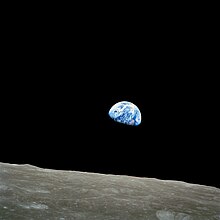Sky (planetary)
The sky is the view that is presented to an observer when he looks from the surface of the earth in the direction of space . Depending on the time of day and weather conditions, different phenomena can be seen both in the atmosphere and in space.
The view from the surface of other planets is also called the sky.
The vault of heaven
The celestial vault is the part of the celestial sphere ( firmament ) that appears to bulge above the horizon . Since the sky does not have a specific distance from the viewer, the " vault " is an illusion. The appearance of the sky as a bowl arched over the earth is present in many mythologies and has contributed to the long existence of a geocentric worldview .
In fact, the vault of the sky does not appear to us as a hemisphere , but rather like a flat shell that is further away on the horizon than at the zenith . This is largely due to the different azure ( sky blue ), in addition, effects of the distance estimation in relation to the visible horizon, as they are the basis of the moon illusion , also contribute.
The day sky
Why is the sky bright?
Penetrates the sunlight , the atmosphere , a portion of the light is scattered and thus illuminates the sky. Without this diffuse radiation , the sky and space would be “black”. The scattered light also makes the earth shine blue and white when viewed from the outside.
Depending on the angle to the sun, the scattered light is polarized differently . When the sky is overcast, the degree of polarization is lower due to multiple scattering, but the angular distribution of the polarization direction remains similar. Multiple scattering also equalizes the wavelength and angle dependence of the scattering, which is why clouds that are not too thick are white. A misty sky, however, shows the predominant scattering in the forward direction by particles that are as large as or larger than the wavelength ( Mie scattering , picture on the right). Without haze, the daytime sky is deep blue.
The sky blue
Light with a blue spectral color is scattered around 10 times more strongly in air than the longer-wave red light because the scattering structure - local density fluctuations in the air - is very small, see Rayleigh scattering . The picture shows that the maximum intensity of direct solar radiation is in the green spectral range, but the maximum of the scattered light is far in the ultraviolet range. This invisible ultraviolet radiation is sufficient for sunbathing in the shade.

The place with the bluest and clearest sky on earth, i.e. the most intense daytime sky blue, is Rio de Janeiro according to measurements by the British National Physical Laboratory . There is very little condensed liquid (water droplets) and dust particles in the upper layers of the atmosphere , which would also strongly scatter long-wave light.
The blue of the sky at sunrise and sunset, and especially the intense blue of the sky during twilight and clear skies, has a different physical cause than Rayleigh scattering. The time of day, also known as the blue hour of the ozone , is based on the special absorption behavior of the ozone layer at a height of 20 to 30 km and was only discovered in 1952 by the American geophysicist Edward Hulburt (1890–1982).
Historical

On July 27, 1760, Leonhard Euler drew light-induced particles into natural oscillations to explain the blue of the sky. In the 19th century, Tyndall showed that light is scattered by colloids (small droplets, dust) ( Tyndall effect ), and Strutt (Baron Rayleigh) that the shorter the wavelengths, the stronger the light is scattered by colloids (Rayleigh scattering) . However, light scattering from colloids could not fully explain the color of the sky, as there is hardly any dependence on the amount of colloids in the atmosphere. Therefore, other scientists have suggested that the much smaller molecules of nitrogen or oxygen must be responsible for the scattering of light. However, there was no explanatory model for scattering on such small particles. It was not until Albert Einstein described a model for photoelectric effects of molecules, which was consistent with many experiments.
However, one inconsistency remained: the deep blue of the sky at dusk. According to the theory of Rayleigh scattering, the short-wave blue component of sunlight should be scattered out during sunset when the sun's rays pass through the long path in the earth's atmosphere (at low point about 35 times longer than at the highest point of the sun) and the sky should actually be in Zenith appear gray to black.
This phenomenon was only discovered in 1952 by the American geophysicist Edward Hulburt and could also be explained by him. Hulburt was able to prove that only one third of the sky blue at the zenith during sunset is based on Rayleigh scattering, but two thirds on the special absorption behavior of the ozone . At dusk, a large part of the blue light in the sky is caused by the ozone layer and only a small part by Rayleigh scattering .

The sky at other times of the day
Similar relationships also apply to the night sky, but are barely visible to the naked eye. In return, a number of other effects can be seen, which the article Night Sky deals with in more detail. The article Starry Sky deals with the sight of the stars, the article Twilight deals with the atmospheric phenomena of the day-and-night change .
View of the sky from the outside
Although the blue part of the sunlight in the atmosphere is scattered in all directions, ie also back into space, the “blue sky” is hardly visible from space. The intensity of the scattered light from the atmosphere is too low in relation to the reflected light from the earth's surface. Seen from space, one therefore only sees the much lighter background of the sky: the earth's surface . From the surface of the earth, the sky is viewed against the dark background of space . The blue sky can still be observed indirectly: the water surfaces of the earth reflect the blue sky where there is no cloud cover. Since the earth is about 70% covered by water, the image of a “ blue marble ” emerges . The night side of the earth is never completely dark due to scattering effects, especially - apart from the cloud cover - due to human-made light pollution .
literature
- Ernst Seidl: Heaven. Ideal image and understanding of the world . MUT, Tübingen 2011, ISBN 978-3-9812736-2-5 .
- H. Dittmar-Ilgen: How the salt gets into the sea water ... Hirzel-Verlag, 2005, ISBN 3-7776-1315-0 , p. 19: The riddle about our blue planet .
- Aden Meinel, Marjorie Meinel: Sunsets, Twilights, and Evening Skies. 2nd Edition. Cambridge University Press, 1991, ISBN 0-521-40647-1 .
- Craig F. Bohren, Alistair B. Fraser: Colors of the Sky. In: The Physics Teacher. Volume 23, Issue 5, 1985, pp. 267-272, doi: 10.1119 / 1.2341808 .
Web links
Individual evidence
- ↑ According to Welf A. Kreiner: Why is the moon so big today? Open-Access Repository of the University of Ulm, 2001 ( doi: 10.18725 / OPARU-60 ), the perceived distance to the horizon corresponds to two to three times the perceived distance from the zenith.
- ↑ R. Hegedüs et al: Polarization patterns of thick clouds: overcast skies have distribution of the angle of polarization similar to that of clear skies. In: J Opt Soc Am A. 24, 2007, pp. 2347-2356, doi: 10.1364 / JOSAA.24.002347 .
- ↑ www.farbimpulse.de
- ^ SI Wawilow: Letters to a German princess on some subjects of physics and philosophy.



